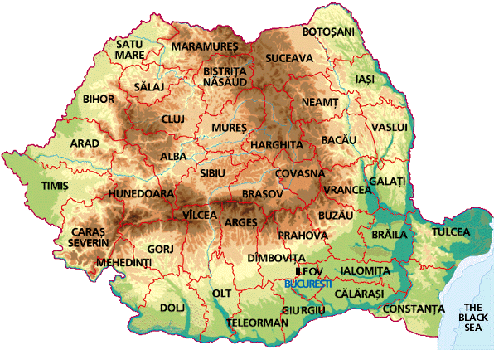Romania – info (en)
- Area: 238.391 km²;
- Capital: Bucharest municipality (divided into 6 administrative districts) with a population of 2,032,000. Situated in the south of the country, in the Romanian Plain (alt 85 m), the city dates from the 14th century and is recorded in writing for the first time in 1459 as residence of Prince Vlad Tepes. Capital of Wallachia in the 17th-19th centuries, then of Romania since 1862;
- Geographical position in Europe: State situated in SE Central Europe, north of the Balkan Peninsula, on the Lower Danube and bordering on the Black Sea. Romania lies between 43°37′07″ and 48°15′06″ Latitude North and 20°15′44″ and 29°41′24″ Longitude East. Parallel 45 (midway between the Equator and the North Pole) crosses Romania 70 km north of its capital and meridian 25 Longitude East (midway between the Atlantic coast and the Urals) runs 90 km west of Bucharest;
- Boundaries: Bulgaria, Yugoslavia, Hungary, Ukraine, Republic of Moldova, Black Sea;
- Population: 21.528.600 (Jan 2008);
- Density: 94,6 inhabitants/km²;
- Ethnic structure: Romanians – 89.5%; Hungarians (including Szecklers)- 6.5%; Roma – 2.5%; other ethnic groups -1.5%;
- Religious denominations: Christian Orthodox – 86.7%; Roman-Catholic-4.7%; Protestant – 3.2%; Greek-Catholic – 0.9%, Evangelical – 0.1%; Unitarian – 0.3%; other religions – 0.4% (preliminary data, March 2003);
- Currency: 1 leu;
- National day: 1 december;
- Romania is a member of the UN, of NATO, and as of January 1, 2007, a full member of the European Union;
- Administrative division: 41 counties (judeţe) and Bucharest municipality.
Călărași (video)


